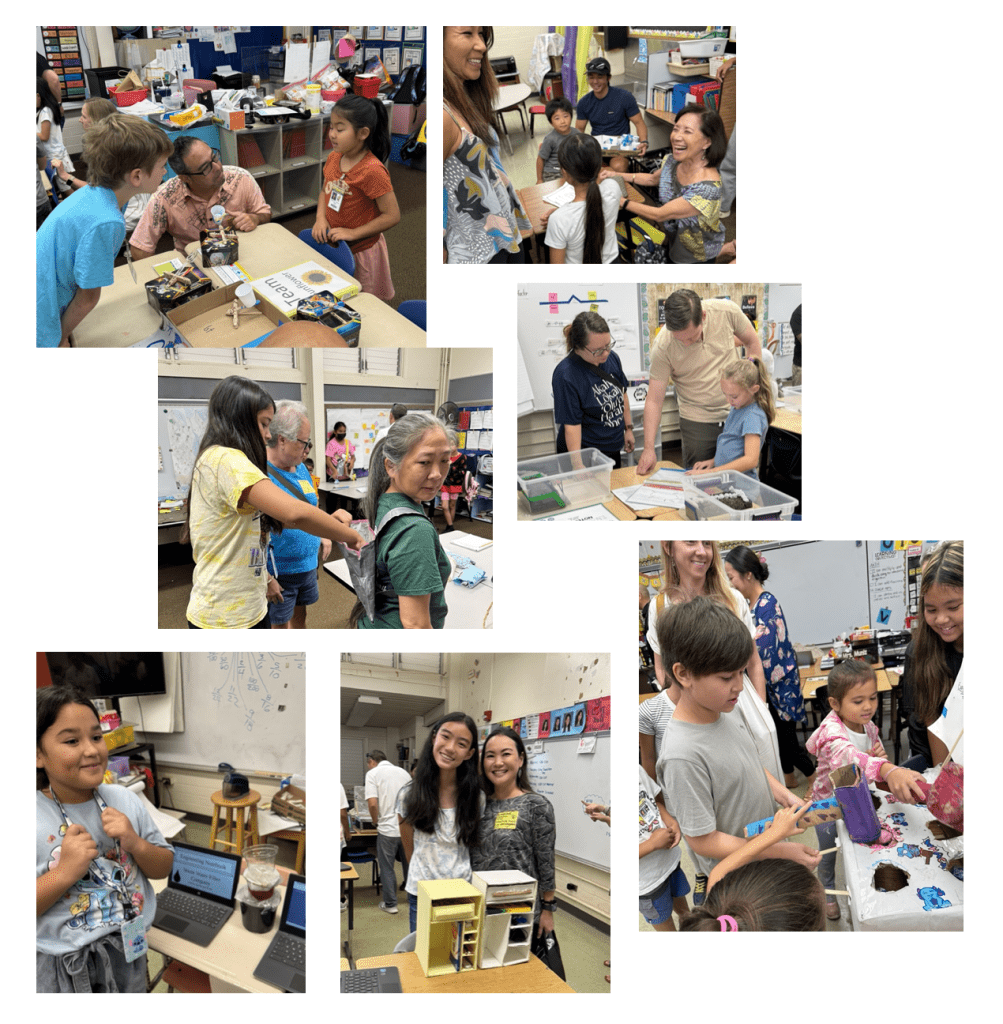Kuʻia ka hele a ka naʻau haʻahaʻa. #1870
Hesitant walks the humble hearted.
A humble person walks carefully so he will not hurt those about him.
Pukui, Mary Kawena, (1983). ʻŌlelo Noʻeau
ALOHA FOCUS FOR THE WEEK: HAʻAHAʻA
Ever hear the idiom, “There’s more than one way to skin a cat”? Besides the perplexing or disturbing image that phrase conjures, I believe our STEM Hōʻike more than exemplifies its meaning. Consistent across each grade level, students were given similar problems to solve yet came up with unique, innovative, creative solutions. No two paper houses in kindergarten looked the same. Each had different design features that guarded against the wind. The same went for the catapults in first grade. Many successfully launched their projective yet each were built differently. Our second graders distinctly constructed barriers to withstand soil erosion. Third graders each had their take on how to best filter debris and particles in water to eventually yield potable water. One third grade class highlighted the myriad of ways to design a hydroelectric water wheel. Fourth graders had their exclusive approach to designing ʻeke (bags) that could carry essentials. Fifth grader showed their creativity in designing a variety of fun and challenging games with just a little bit of cardboard and tape. Meanwhile sixth graders had the freedom to apply the Engineering Design Process to any challenge they encountered in everyday life. Even our preschoolers showed their prowess at problem-solving by designing boats that float and hold cargo without sinking. Seeing how every student/group had their own unique spin on their engineering challenge, validates that there is no one right way. Acknowledging this takes haʻahaʻa.

Too often, especially in traditional, Western education, we approach a task thinking there is only one correct answer and only one correct way to get to that answer. And while it might be true there’s one correct answer when we are solving a simple math problem, there’s often many different ways to get that answer. Further, real life problems are much more complex with a multitude of different “right” answers and solution approaches. Even when constrained by limited resources, design solutions are only bounded by our creativity and willingness to try new things (and fail in the process). When we haʻahaʻa we empty ourselves – even if temporarily – of judgements, fears and our own ego so that we can be more open and receptive to ideas, even the ones coming from within.
In the case of our STEM Hōʻike, we have been honing that skill of accepting failure as part of the learning process. From Silver Linings Day to the Engineering Design Process, we strive to have students release any fear of failure damaging their ego. Instead, we endeavor for students to see learning and making improvements from failure as an asset, a sign of perseverance. And in part, STEM Hōʻike gives us a window into seeing kids demonstrate this mindset.
Mahalo to their teachers for all of the thought, planning, and perspiration into ensuring their students were prepared for the event. Their efforts, as seen through the actions of their students, shone bright. Mahalo nui loa to Karen Kimura for organizing the STEM Hōʻike and most of all for supporting our teachers in helping them and their students attain success.
5 PURSUITS of HAʻAHAʻA:
Inspired by Gholdy Muhammad
In honor of Earth Day, please watch Wonder Walkers written and illustrated by Micha Archer. Then with you child, answer the following:
- IDENTITY: How is nature or the ʻāina important to you and your ʻohana?
- SKILLS: The children use figurative language (personification) as they wonder about different things they see on their walk. Share your favorite and tell why.
- INTELLECT: Research the origins of Earth Day and it’s significance to mālama ʻāina.
- CRITICALITY: Share why you think it’s important to mālama ʻāina.
- JOY: Go on a Wonder Walk at a favorite outdoor space and come up with your own wonderings.
SMARTER BALANCE TESTING
Our school will begin our Smarter Balanced Assessment (SBA) testing for hāumana in grades 3-6 on Monday, April 22, through May 14, 2024, with make-up test sessions to follow. For those in testing grades, it is important that your keiki is well-rested, eats a healthy breakfast, and arrives to school on time daily during this testing period.
Please note that if haumāna are tardy, they will be sent to the library and unable to take the assessment on that day. We kindly ask for your kōkua to ensure that your child is punctual, especially during the testing period.
Additionally, please have your keiki bring their headphones to school as they may be required for certain portions of the assessment.
Mahalo nui for kōkua and support in helping to create the best testing environment for our haumāna. If you have any questions or concerns, please do not hesitate to contact us—Aloha nui iā kākou.
CONTINUED PRACTICES:
NOʻAHUNA OF ALOHA
See Uncle Pono Shim explain the Noʻahuna, the esoteric meaning, of Aloha as taught to him by Aunty Pilahi, the Keeper of Secrets.
WEAR PINK FOR MAUI WEDNESDAYS
Join us in letting “that light, that divine inspiration that Aunty Pilahi Paki says is given to you at your very beginning, come through and let your ALOHA join with the ALOHA of the collective to bring about healing.”
DAILY VIRTUAL PIKO
At the Daily Piko, we share thoughts on the Aloha value for the week which helps us become centered and ready to learn. We begin at 8 AM everyday except Wednesdays.
UPCOMING EVENTS
| Apr 22 – May 10 | Smarter Balance Assessment testing |
| Wed, May 1 | 5 PM KES School Community Council Meeting |
| Fri, May 3 | Waiver Day – No Students |
| Sat, May 11 | 8:30 – 11:30 AM Campus Beautification |
| Fri, May 17 | May Day |